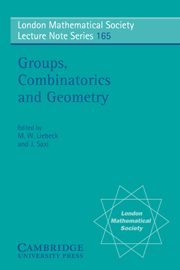Book contents
- Frontmatter
- Contents
- Authors' Addresses
- Introduction
- Part 1 Sporadic groups
- Part 2 Moonshine
- Part 3 Local and geometric methods in group theory
- Part 4 Geometries and related groups
- Part 5 Finite and algebraic groups of Lie type
- Part 6 Finite permutation groups
- Part 7 Further aspects of simple groups
- 32 Symmetric presentations I: Introduction, with particular reference to the Mathicu groups M12 and M24
- 33 Finite and, locally finite groups containing a small subgroup with small centralizer
- 34 Some topics in asymptotic group theory
- 35 The 3-modular characters of the McLaughlin group McL and its automorphism group McL.2
- Part 8 Related topics
35 - The 3-modular characters of the McLaughlin group McL and its automorphism group McL.2
Published online by Cambridge University Press: 07 September 2010
- Frontmatter
- Contents
- Authors' Addresses
- Introduction
- Part 1 Sporadic groups
- Part 2 Moonshine
- Part 3 Local and geometric methods in group theory
- Part 4 Geometries and related groups
- Part 5 Finite and algebraic groups of Lie type
- Part 6 Finite permutation groups
- Part 7 Further aspects of simple groups
- 32 Symmetric presentations I: Introduction, with particular reference to the Mathicu groups M12 and M24
- 33 Finite and, locally finite groups containing a small subgroup with small centralizer
- 34 Some topics in asymptotic group theory
- 35 The 3-modular characters of the McLaughlin group McL and its automorphism group McL.2
- Part 8 Related topics
Summary
Introduction
McLaughlin's sporadic simple group McL was originally constructed (see) as a permutation group on 275 letters. It is a simple group of order 898128000 = 27.36.53.7.11. It is now known to be the pointwise stabilizer of a 2-dimensional sublattice in the Leech lattice. Its maximal subgroups were found by Finkelstein (see). The modular character tables for the relevant primes p = 2, 7 and 11 were found by Thackray. The 5-modular character tables were found by Hiss, Lux and Parker, up to a few ambiguities (see). These ambiguities together with others in the values of the 5- modular characters 560 and 3038 of the automorphism group of McL, denoted by McL.2, were resolved by Suleiman (see). The main purpose of this paper is to complete the 3-modular character table of McL and to find the 3-modular character table of McL.2.
The 3-modular character table of McL
In this section we are going to complete what has been done by R. Parker on the 3-modular characters of McL. To do so we have to work out again most of the 3-modular characters using the techniques of the ‘Meat-Axe’ which is the main tool in our work. We then use the method of ‘condensation’ (see) to complete the 3-modular character table of McL.
The central characters modulo 3 give the block distribution of the ordinary irreducible characters. There are three blocks of defect zero. These blocks are B1 = {5103}, B2 = {8019a} and B3 = {8019b}. Hence, 5103, 8019a and 8019b are three 3-modular irreducible characters in McL.
Information
- Type
- Chapter
- Information
- Groups, Combinatorics and Geometry , pp. 422 - 437Publisher: Cambridge University PressPrint publication year: 1992
